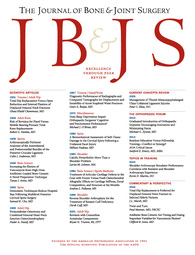
ARTHROPLASTY
Similar infection rates with the use of erythromycin and colistin-loaded cement in TKA
This report has been verified
by one or more authors of the
original publication.
J Bone Joint Surg Am. 2013 May 1;95(9):769-74. doi: 10.2106/JBJS.L.00901
3000 patients undergoing total knee arthroplasty (TKA) (2948 of whom completed the study) were randomized to the use of either antibiotic-loaded or non-antibiotic-loaded cement in the fixation of their prosthesis. The primary goal of this study was to compare infection rates between the two groups and the secondary goal was to determine if risk factors existed for deep infection. Results indicated that there was no difference between the two groups in terms of deep or superficial infection rates. In addition, male sex and an operative time of longer than 125 minutes were determined to be risk factors for deep infection.
Unlock the full ACE Report
You have access to {0} free articles per month.Click below to unlock and view this {1}
Unlock NowCritical appraisals of the latest, high-impact randomized controlled trials and systematic reviews in orthopaedics
Access to OrthoEvidence podcast content, including collaborations with the Journal of Bone and Joint Surgery, interviews with internationally recognized surgeons, and roundtable discussions on orthopaedic news and topics
Subscription to The Pulse, a twice-weekly evidence-based newsletter designed to help you make better clinical decisions
Exclusive access to original content articles, including in-house systematic reviews, and articles on health research methods and hot orthopaedic topics
Or upgrade today and gain access to all OrthoEvidence content for just $1.99 per week.
Already have an account? Log in


Subscribe to "The Pulse"
Evidence-Based Orthopaedics direct to your inbox.
{0} of {1} free articles
Become an OrthoEvidence Premium Member. Expand your perspective with high-quality evidence.
Upgrade Now













































































